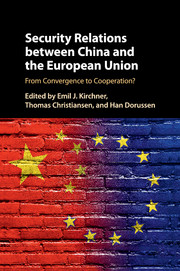Book contents
- Frontmatter
- Dedication
- Contents
- List of Tables
- Preface and Acknowledgements
- Abbreviations
- List of Contributors
- 1 EU–China Security Cooperation in Context
- 2 Chinese and EU Views of Military Security: Crafting Cooperation
- 3 Regional Solutions for Regional Confl icts? The EU, China and their Respective Neighborhoods
- 4 Aims versus Deeds: EU–China Cooperation in Nuclear Nonproliferation
- 5 Terrorism and Organized Crime: Common Concerns but Different Interests
- 6 Chinese and EU Climate and Energy Security Policy
- 7 Competing or Converging Claims on International Order? The EU, China and Human Security
- 8 Civil Protection: Identifying Opportunities for Collaboration
- 9 Cybersecurity and EU–China Relations
- 10 The Economic Security Dimension of the EU–China Relationship: Puzzles and Prospects
- 11 Is Securitizing Migration a Mandatory Choice? Lessons from the EU and China
- 12 Against the Odds: (Considerable) Convergence and (Limited) Cooperation in EU–China Security Relations
- Index
- References
6 - Chinese and EU Climate and Energy Security Policy
Published online by Cambridge University Press: 05 September 2016
- Frontmatter
- Dedication
- Contents
- List of Tables
- Preface and Acknowledgements
- Abbreviations
- List of Contributors
- 1 EU–China Security Cooperation in Context
- 2 Chinese and EU Views of Military Security: Crafting Cooperation
- 3 Regional Solutions for Regional Confl icts? The EU, China and their Respective Neighborhoods
- 4 Aims versus Deeds: EU–China Cooperation in Nuclear Nonproliferation
- 5 Terrorism and Organized Crime: Common Concerns but Different Interests
- 6 Chinese and EU Climate and Energy Security Policy
- 7 Competing or Converging Claims on International Order? The EU, China and Human Security
- 8 Civil Protection: Identifying Opportunities for Collaboration
- 9 Cybersecurity and EU–China Relations
- 10 The Economic Security Dimension of the EU–China Relationship: Puzzles and Prospects
- 11 Is Securitizing Migration a Mandatory Choice? Lessons from the EU and China
- 12 Against the Odds: (Considerable) Convergence and (Limited) Cooperation in EU–China Security Relations
- Index
- References
Summary
Climate change impacts on and is impacted by areas such as development, economy, security and energy. The concept of climate security encompasses a number of different phenomena and has increasingly been conceptualized in terms of fragility and resilience. Climate change can threaten people's survival and wellbeing (Barnett 2003: 7) and act as conflict multiplier (Adger and Puhin 2014). It can put pressure on economic, social and political systems as well as development processes. Failure to manage these pressures can increase the instability of states and societies. Climate security policy aims to strengthen the resilience of states and societies. This includes climate change mitigation and adaptation efforts, development and humanitarian aid programs as well as peace-building and conflict prevention (Mabey et al. 2011: 12–16; Rüttinger et al. 2015).
Climate security is closely interrelated with energy security. Burning fossil fuels to produce energy is the leading source of greenhouse gas (GHG) emissions, which cause climate change. In turn, climate change affects the security of energy supply (Umbach 2012). Climate change and energy security policies can contradict or reinforce each other. When measures to ensure energy security include a shift toward an increasing share of renewable sources, both policy areas are synergetic. When a move toward more domestic energy generation includes increasing use of fossil fuels, the increase of energy security is detrimental to climate policy goals.
Both the EU and China are large GHG emitters, which makes them major contributors to climate change. In 2013, China emitted 29 percent and the EU 11 percent of total global carbon dioxide emissions. The United States accounted for a 15 percent share (Oliver et al. 2014: 4). China and the EU also share a large degree of energy import dependence. In 2013, the EU imported 53.2 percent of its gross energy consumption (European Commission 2014a; Eurostat 2015) while China's import dependence also is above 50 percent.
Although both the EU and China are fully aware of the threats of climate change to human wellbeing and hold concerns of energy security, their perceptions of and responses to climate and energy security diverge. This fosters both cooperation and persisting divergences at global and bilateral levels.
The following section elaborates EU and Chinese perceptions of climate and energy security, followed by a discussion of the two players’ responses to perceived security concerns over the past two decades.
- Type
- Chapter
- Information
- Security Relations between China and the European UnionFrom Convergence to Cooperation?, pp. 102 - 123Publisher: Cambridge University PressPrint publication year: 2016
References
- 2
- Cited by



